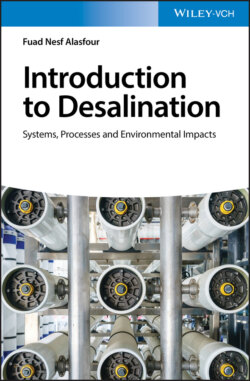Читать книгу Introduction to Desalination - Fuad Nesf Alasfour - Страница 22
1.4.2 Membrane Desalination System
ОглавлениеThere are several types of membrane technologies that are used today in the market, and the most predominant one is RO; the separation process using RO depends on the process of pressurizing feed fluid against semipermeable membrane, and such pressure causes only water molecules to cross (pass, migrate) through membrane, where salts and unwanted constituents such as minerals are rejected in a form of brine or concentrate. In RO process there is no heat addition during desalination process, hence no feed phase change occurred during separation process; besides RO technology, there are other membrane desalination systems used at small and limited scale such as nanofiltration (NF), ultrafiltration (UF), and microfiltration (MF).
The RO desalination system is characterized with low amount of energy consumption compared with conventional thermal types and with high water recovery, but membrane lifetime is short due to fouling and scaling; unlike thermal system RO can only treat feed salinity from 50 to 46 000 ppm, and the value of SEC varies from 1 to 6 kWh/m3. As per electrical demand an example of 50 mG/d capacity RO plant requires 20–35 MW in case of using feed seawater (sea water reverse osmosis [SWRO] system) and 8–20 MW in case of using brackish feedwater (brackish water reverse osmosis [BWRO] system).
The following are advantages and disadvantages of RO system:
Advantages of RO:Low energy consumption compared with thermal desalination system.Small in size and compact.Low value in investment.
Disadvantages of RO:Membrane has certain thermal stability limit.Life of a membrane is limited and short.Low feedwater can treat only salinity compared with thermal system.Costly in pretreatment.Use electrical power to drive system.Costly in maintenance.
